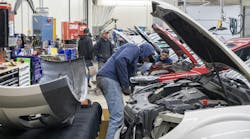Aftermarket vehicle of the month
1970 Super Bee: A sting like no other
In 1970, the HEMI engine had a 425 horsepower rating, but dynamometer tests revealed this number was low (probably for purposes of young buyers being able to obtain insurance). An estimated 500-horsepower (gross) is probably more accurate.
The beauty of the 426 HEMI engine is the hemispherical combustion chamber design, which delivers more fuel and air with each intake stroke than any other chamber design for normally aspirated powerplants. The hemispherical cylinder-head design brings high volumetric efficiency and coupled with 426 cubic inches of displacement, these engines are hard to beat.
This particular car was factory-fitted with additional equipment to enhance standing start, straight-line performance capabilities — namely a competition-type four-speed manual transmission (HEMI-equipped cars with four-speed manual transmissions came with special gears that featured thicker, coarser-pitched teeth, in addition to a larger clutch spline) — plus an optional 4.10:1 ring and pinion rear end. A HEMI with the rugged four-speed transmission, combined with the low rear gear, was the ultimate combination for Mopar racers at the time.
Standard equipment on the 1970 HEMI Super Bee included the "RAMCHARGER" hood with twin functional air scoops, delivering fresh air to the hungry HEMI. These cars had HEMI emblems scrawled across the sides of the scoops, and while it was impressive to onlookers to know the car was equipped with the massive HEMI engine, it did make impromptu street face-offs difficult. Few people wanted to mess with the mighty HEMI.
Aloha gives the Bee new life
Aloha Automotive Services in Port Washington, Wis., restored the Super Bee top to bottom and inside and out. Perhaps the most significant part of the process was the complete engine overhaul (blueprinted to original factory specifications), which included running it on a stand to break in the camshaft. After installation, the engine was fully tested on a Dyno Jet chassis dynamometer. The transmission and differential also were fully rebuilt as per factory specs; nothing can be overlooked in a high-quality restoration.
One unique feature of the Aloha-built HEMI was the addition of a Pertronix electronic ignition system, which was completely enclosed in the stock distributor and eliminated the points. From the outside, it retained the standard factory appearance, but with improved ignition performance.
The car also received new interior pieces and replated chrome as needed, a new vinyl top, new side stripes and a set of Goodyear Polyglas F60-15 original equipment-type tires.
It was a six-month restoration, but when Tommy White took the Bee out for its maiden test drive, it looked, felt and performed just like the day it was built, only perhaps a little better, thanks to the talented techs at Aloha.
At any given time during the process, car owner Bill Wiemann could visit the Aloha Web site (www.alohadreamcars.com), click on "Webcam" and watch live as the team worked on his prized Mopar. Muscle-car restoration is big business and provides car owners a place to truly make their dreams come true.



